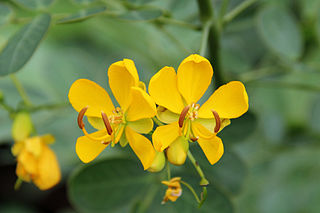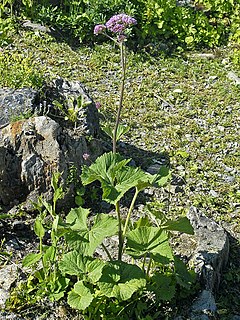
Genista is a genus of flowering plants in the legume family Fabaceae, native to open habitats such as moorland and pasture in Europe and western Asia. They include species commonly called broom, though the term may also refer to other genera, including Cytisus and Chamaecytisus. Brooms in other genera are sometimes considered synonymous with Genista: Echinospartum, Retama, Spartium, Stauracanthus, and Ulex.

Cassia is a genus of flowering plants in the legume family, Fabaceae, and the subfamily Caesalpinioideae. Species are known commonly as cassias. Cassia is also the English common name of some species in the genus Cinnamomum of the family Lauraceae. Species of the genera Senna and Chamaecrista were previously included in Cassia. Cassia now generally includes the largest species of the legume subtribe Cassiinae, usually mid-sized trees.

Ixia is a genus of cormous plants native to South Africa from the family Iridaceae. Some of them are known as the corn lily. Some distinctive traits include sword-like leaves and long wiry stems with star-shaped flowers. It usually prefers well-drained soil. The popular corn lily has specific, not very intense fragrance. It is often visited by many insects such as bees. The Ixia are also used sometimes as ornamental plants.

Barbosella is a genus of mostly creeping orchids. The genus has about 20 species, widespread across the West Indies and Latin America from Mexico and the Lesser Antilles to Argentina. Named after João Barbosa Rodrigues, an investigator of Brazilian orchids. They have solitary flowers with a unique lip base that works like a ball and socket.

Hierochloe is a genus of plants in the grass family known generally as sweetgrass. These are perennial rhizomatous grasses found primarily in temperate and subarctic regions of Eurasia and North America, although some species extend southwards into Australia and Latin America.

Hierochloe odorata or Anthoxanthum nitens is an aromatic herb native to northern Eurasia and North America. It is a sacred grass of the indigenous peoples of Canada and the United States. It is used as a smudge, in herbal medicine and in the production of distilled beverages. It owes its distinctive sweet scent to the presence of coumarin.

Senna bicapsularis is a species of the legume genus Senna, native to northern South America, from Panama south to Venezuela and Colombia, and also the West Indies. Common names include rambling senna, winter cassia, Christmas bush, money bush, and yellow candlewood.

Bruguiera is a plant genus in the family Rhizophoraceae. It is a small genus of five mangrove species and three hybrids of the Indian and west Pacific Ocean region, its range extending from East Africa and Madagascar through coastal India, Sri Lanka and Southeast Asia to northern Australia, Melanesia and Polynesia. It is characterised by calyces with 8-16 lanceolate, pointed lobes, 16-32 stamens, explosive release of pollen, and viviparous propagules. It is named in honour of French explorer and biologist Jean Guillaume Bruguière (1750–1798). Recently, the eighth taxa of Bruguiera, B. × dungarra was recognised as occurring in northern Australia.

Dysphania is a plant genus in the family Amaranthaceae, distributed worldwide from the tropics and subtropics to warm-temperate regions.

Adenostyles alliariae is herbaceous perennial plant belonging to the genus Adenostyles of the family Asteraceae.









